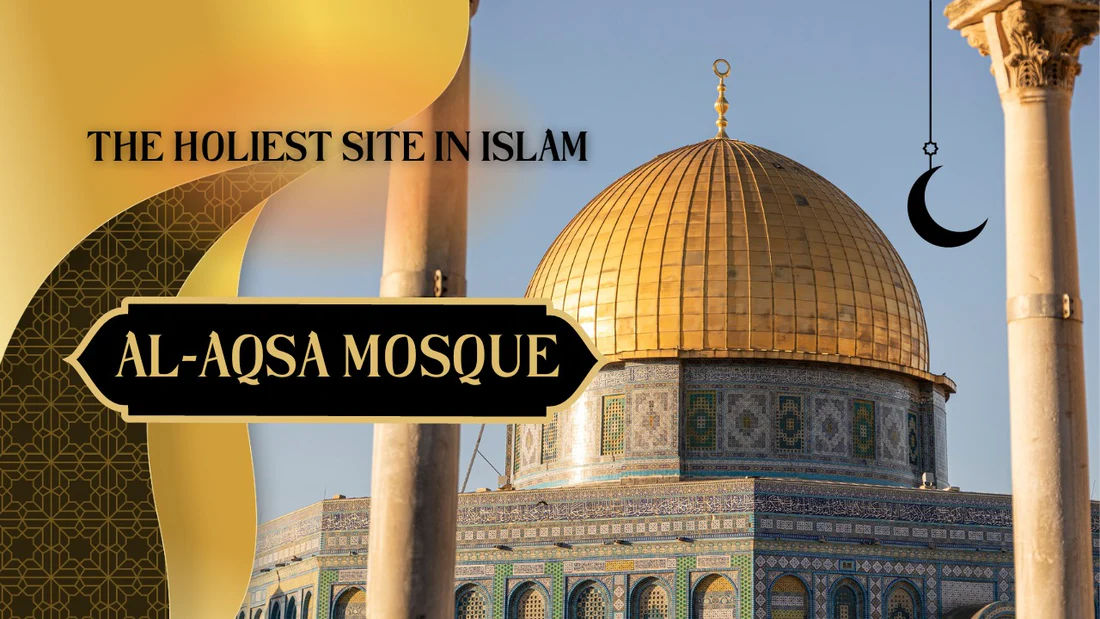“the ‘al-aqsa’ mosque, located in the heart of jerusalem, is a well-known mosque among muslims worldwide. Indeed, mentioned in the noble quran as well as in numerous hadiths, it holds a significant place among mosques. We will be discussing it in this article, insha allah.”
where is al-aqsa located and where does its name come from?
Located in the southeast of the old city of jerusalem, the dome of the rock of al-aqsa is visible from the other side of the city.
The entire complex enclosed by its outer walls covers an area of 144,000 square meters and includes mosques, prayer halls, courtyards, and religious monuments.
In arabic, “al-aqsa” has two meanings: “the farthest, ” in reference to its distance from mecca, as mentioned in the quran, the holy book of islam, and “the supreme, ” in reference to its status among muslims.
For muslims, it is also the place where the prophet muhammad led his fellow prophets in prayer during a miraculous night journey known as the miraj.
Why is this site so important?
In addition to its religious significance, al-aqsa is a symbol of the culture and nation of the palestinian people.
The gilded dome of the rock is familiar to muslims worldwide, and praying at the site is considered a great privilege.
Before the establishment of modern borders, pilgrimages to the holy muslim cities of mecca and medina often included a stop in jerusalem.
The vast courtyards of al-aqsa still attract tens of thousands of worshipers who gather there every friday for congregational prayers.
Aqsa mosque
during the holy month of ramadan, the place is bustling with worshipers who come to the mosque for tarawih prayers (night prayers).
On the occasion of eid al-fitr, which marks the end of ramadan, the atmosphere becomes more festive: there are songs, processions, and candies are distributed to passersby.
Jews refer to this place as the temple mount, and many believe that two ancient jewish temples once stood there: the temple built by king solomon (suleiman in arabic), which was destroyed by the babylonians, and the second temple, which was destroyed by the romans.
The site houses the “foundation stone, ” where, according to devout jews, the creation of the world began.
Since the start of the israeli occupation of east jerusalem in 1967, the site has been a source of controversy between muslim worshipers and groups seeking complete jewish control over the area.
What are the main monuments of al-aqsa?
Al-aqsa houses several monuments associated with the city of jerusalem and features some of the best-preserved architectural elements from the early islamic period.
In addition to religious structures and buildings, there are 32 water sources on the site, including wells used for ablutions.
Several minbars (pulpits) and historical schools can also be found within the walls of al-aqsa, some dating back to the mamluk and ayyubid periods.
The dome of the rock
according to islamic belief, the dome of the rock housed the first qibla, the direction in which muslims prayed.
In islam, al-aqsa is one of the first mosques, after the kaaba, the black cube in mecca, toward which muslims perform the hajj and umrah pilgrimages and to which they direct their prayers.
The mosque plays a key role in the miraculous night journey of the prophet muhammad to the heavens, known in arabic as “al-isra wa al-miraj. “
according to muslims, the prophet muhammad met the 124,000 prophets who came before him and led them in prayer at the al-aqsa mosque.
In arabic, the dome of the rock is called “qubbat al-sakhra” and holds great religious and historical significance.
The structure was commissioned by the umayyad caliph abd al-malik ibn marwan between 691 and 692, on the rock from which the prophet is believed to have ascended to the heavens.
Islamic belief asserts that a divine ladder descended from the highest of heavens to the rock of ascension. The rock rises about one and a half meters above the ground, in a place known as the “chapel of the prophet. “
the dome of the rock is one of the earliest examples of islamic architecture and serves as the archetypal structure for subsequent islamic mosques and buildings. Its octagonal design features four entrances, and its interior is adorned with verses from surah al-isra in the quran. These inscriptions are among the earliest surviving copies of the quranic text.
Inside the mosque, worshipers are greeted by large stained glass windows finely decorated with islamic patterns and text.
The mosque also houses one of the oldest surviving mihrabs, a niche in the mosque’s wall indicating the direction of prayer towards mecca.
The western wall
one of the prominent sites within al-aqsa is the western wall, also known as the wailing wall or the buraq wall, on the southwest edge of the mosque.
The wall is located between the gate of the prophet and the gate of morocco, and the area also includes a small mosque, which was built between 1307 and 1336.
Standing at a height of around twenty meters and a length of 50 meters, the wall is believed to be the place where the prophet muhammad tethered a winged creature resembling a horse, known as al-buraq, before his ascent to the heavens.
The western wall holds great significance for jews, who believe it is the last remaining structure of herod’s temple, destroyed by the romans in 70 ce.
Every year, tens of thousands of jews gather and pray at the site, inserting written prayers into the crevices of the wall.
Al-qibli mosque
the silver-domed structure is located towards the southern wall of al-aqsa. It was the first building constructed by muslims on the site and is considered one of the most significant structures within the complex, serving as the location where the imam stands to lead the faithful in prayer.
When muslims entered jerusalem in 638 ce, the second caliph of islam, umar ibn al-khattab, and his companions ordered the construction of the mosque in what was then a barren and neglected area.
Originally, the mosque was a simple building supported by wooden beams, but the structure seen today was built by the umayyad caliph walid ibn abd al-malik ibn marwan in the early 8th century.
Throughout its history, the mosque has endured numerous earthquakes and attacks, which have left their marks on the original structure.
Its most recent major renovation took place during the ottoman period when sultan suleiman the magnificent restored several sites within the mosque area, installing carpets and lanterns.
Today, the al-qibli mosque has nine entrances. The main entrance is located in the middle of the north facade of the building. Inside, stone and marble columns rise to support the structure.
The stone columns are ancient, while the marble columns were part of renovations in the early 20th century.
Spacious enough to accommodate approximately 5,500 worshipers, the mosque measures 80 meters by 55 meters.
Inside, the mosque’s dome is made of wood, and the columns are adorned with glass mosaics featuring depictions of plants, geometric patterns, and verses from the quran.
Who built the al-aqsa mosque, the largest mosque in jerusalem?
“this question has been the subject of differences of opinion. According to some, the al-aqsa mosque is said to have been built by the prophet ya’qub (peace be upon him), the son of isaac, the son of ibrahim. For others, it is attributed to the prophet solomon (peace be upon him).
However, given that there is a gap of more than 40 years between him and the prophet ibrahim (peace be upon him), we can assume that prophet solomon (peace be upon him) might have only undertaken the restoration of the mosque, which was originally built earlier. This version is attributed to ibn kathir (may allah have mercy on him). “
hadith on the al-aqsa mosque
imam muslim reported in his sahih, on the authority of abu dharr (may allah be pleased with him):
“i asked the messenger of allah (peace and blessings be upon him), ‘which was the first mosque built on earth? ‘ he replied, ‘the sacred mosque (al-masjid al-haram). ‘ ‘and then? ‘ i inquired. He answered, ‘the al-aqsa mosque in jerusalem. ‘ i asked, ‘how many years separated them? ‘ he said, ‘forty years. ‘ he added, ‘wherever you may be when the time for prayer comes, perform the prayer, for the entire earth is a place of worship for you. ‘”
furthermore, based on an authentic chain of transmission, the prophet (peace and blessings be upon him) said:
“when solomon, the son of david, built bayt al-maqdis (jerusalem), he asked allah for three things: supernatural power, which allah granted him, a kingdom like no one after him would have, which allah also granted, and when he finished the construction of the mosque, he asked allah to forgive all the sins of anyone who undertakes a journey to this mosque solely to perform prayers, making them as pure as the day they were born. “
on the merit of praying in the al aqsa mosque
while, as a general rule, muslims are not permitted to travel solely for the purpose of visiting a mosque, there is a hadith that informs us that it is indeed permissible to undertake a journey with the specific intent of visiting the al-aqsa mosque.
Furthermore, the merit of performing prayers within this mosque is mentioned. The prophet (peace and blessings be upon him) said:
“one should not undertake a journey for the purpose of prayer except to these three mosques: the sacred mosque (in mecca), my mosque (in medina), and the al-aqsa mosque (in jerusalem). ” this hadith is reported by malik, al-bukhari, and muslim.
Regarding the reward for offering prayers in this mosque, another hadith mentions it. The prophet (peace and blessings be upon him) said:
“the reward for a prayer performed in the sacred mosque (in mecca) is equivalent to the reward of one hundred thousand prayers offered elsewhere. The reward for a prayer performed in my mosque (in medina) is equivalent to the reward of one thousand prayers offered elsewhere. As for the reward of a prayer performed in the al-aqsa mosque (bayt al-maqdis), it is equivalent to the reward of five hundred prayers offered elsewhere. “
the bayt al-maqdis mosque in the noble quran
it is in the chapter “al-isra” (the night journey) that allah mentions the al-aqsa mosque. This is one of the reasons why the mosque in jerusalem is well-known among many muslims.
Allah says in the quran:
the approximate translation of the meaning of the first verse of surah 17 (al-isra) is as follows:
glory and purity to him who at night made his servant [muhammad] travel from the mosque al-haram to the mosque al-aqsa whose surroundings we blessed, in order to show him some of our wonders. It is he, truly, who is the hearer, the clairvoyant.
Conclusion
it’s important to clarify that the al-aqsa mosque does not have a golden dome, although it is often represented that way.
The golden dome nearby is the “dome of the rock, ” which is indeed a separate place, also known as the qubbat al-sakhra mosque. These are two distinct locations.

